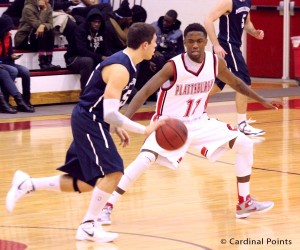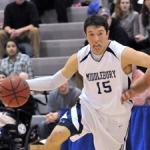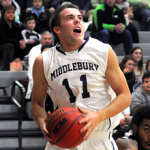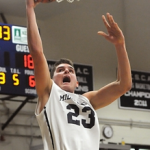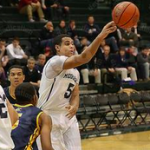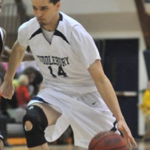With eight games completed and conference play coming on fast, Damon and I wanted to reflect on what we’ve learned about the 2013-14 Panthers, and discuss what the rest of the season might hold in store. We sent a list of questions and answers back in forth, and this is the finished product. We discussed player development, reasons for concern and optimism, surprising storylines, projected finishes, and more. Thanks for reading, and happy New Year.
We had a number of preseason concerns for this team. What concern of yours has been most alleviated over the first semester? What concern remains strongest? What new concern do you have after the first eight games of the season?
Jeff: Going into the season, I was worried that Matt St. Amour was too one-dimensional to get starter minutes. I thought he was a great shooter, but was concerned that his defense, athleticism, and other offensive skills were lagging. This was dumb because we had both seen him play in person, and came away most impressed with his passing and vision, not his scoring. I think maybe I bought a little too much into the idea that the transition from Vermont high school hoops to the NESCAC would limit him more in the other areas. (The scouting lesson: trust your eyes.) What we saw in the fall semester was a complete player. While his shooting was underwhelming, his defense, passing, ball-handling, off the ball motion, vision, awareness and rebounding were all better than I expected. When he is on the court, the team plays better: the ball moves faster, there is more space to operate, and the offense is more efficient. He’s one of my favorite players to watch because of everything that he brings to the table.
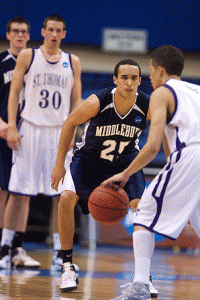
The loss of Thompson remains all too apparent in 2013-14.
The concern that remains the strongest from preseason is the hole left by Nolan Thompson’s graduation. We were used to opponents’ leading scorers being kept to about 50% of their season average against Middlebury, because of Thompson’s shutdown defense. This year, the opponent’s leading scorer on the season has scored above his season average in six of eight games. In other words, Middlebury has gone from otherworldly to sub-par in their ability to stop elite individual opponents. And the effects have been noticeable: As a team, Middlebury is allowing 11.4 points per game more this season than last. (And already has as many losses as they did all of last regular season.).
The new concern that has emerged is that this team might be without Dylan Sinnickson for the rest of the year. This is a player who was on the court fot 38 minutes in the opening weekend, after not having played for a year and a half, and scored 29 points, on 10-20 FG shooting, 5-7 from three. He is an exceptional shooter and a strong athlete on defense and in the fast break as well. Now, we’re not sure if he will be back in uniform for the rest of the season, and that, to me, would eliminate any hopes Middlebury had of winning the conference.
Damon: When we talked preseason about the potential problems this team might face, the most drastic one in my mind was that they just might not be good enough, deep enough or ready enough to play at a high level. That fear has been largely assuaged as the Panthers have won six of their first eight games—the same number of which were on the road—and have competed in every game they’ve played this season. The early season hasn’t been without its miscues—Middlebury looked decidedly mediocre when it played against both RPI and Castleton State—but winning ugly is, when necessary, an important process for a young team to learn. Barring a major disappointment in NESCAC play, this Middlebury team appears to have quelled any concern I had about their ability to compete with—if not beat—the best teams in the conference and the country.
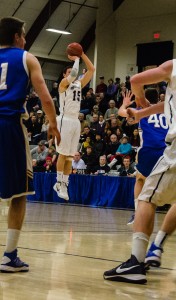
Joey Kizel leads the conference in minutes per game.
The concern that remains after eight games is the workload that has been placed on the shoulders of Joey Kizel. Without a consistent second scoring option (though Hunter Merryman played 4-5 great games and Matt Daley appears to be that and more when healthy), Kizel has had to carry the team offensively for long stretches, which he can undoubtedly do, but the All-American guard is most lethal when he can pick his spots late in games and take over for the final five minutes. Unfortunately he has been forced into taking shots and making plays that he wouldn’t normally attempt in certain game situations. Playing for long stretches at maximum effort on the offensive end also threatens to jeopardize his play on the defensive end, where Kizel’s active hands and keen sense of spacing allow him to make disruptive plays that outlet into transition opportunities on the other end for the Panthers. I’m sensitive, as we all are, to the defensive—and offensive—void left by Nolan Thompson, but I still believe that Middlebury’s optimal defensive identity this season is as a team that gets into the passing lane, forces turnovers and gets out in transition, which plays more to the strengths of Kizel, Brown, St. Amour, Jensen and others. Whether it’s Merryman, St. Amour, Daley or someone else, therefore, finding a reliable scorer who can make plays when the offense is out of rhythm—tough buckets, as some might say—remains a crucial, missing ingredient to Middlebury’s potential success.
As for a new concern, I don’t think anything rivals the Sinnickson situation. When one considers (as you pointed out) Dylan’s efficiency as a shooter and ability to create his own shot in light of the team’s struggles to find a second scoring option to complement Kizel, having number 41 on the floor would lift a barbell size weight off the offense and give Jeff Brown greater flexibility in his rotation and lineups. Jeff: You make a good point about winning ugly. One thing that we should keep in mind is that Jeff Brown uses a lot of fall semester games to give opportunities and toy with lineups, and results or score differences, for Middlebury more than most teams, often are sacrificed for the sake of long-term improvement.
Matt St. Amour, Matt Daley and Jake Brown (the three underclassmen we identified preseason as the players who would make or break Middlebury’s season) all demonstrated flashes of brilliance, but were, on the whole, inconsistent through the first eight games. What should we expect from each during NESCAC play? Can the Panthers get consistent play from all three?
Jeff: This is a good question because we really don’t know the answer. These three players will all define themselves with their play going forward. St. Amour is the surest thing. He will continue to see starter minutes, improve his scoring, and might surpass Jensen and Merryman and finish the season as Middlebury’s second most valuable player. Jake Brown is capable of running the point, but needs to let the game come to him a bit more. I think he learned from his ups and downs in the fall and will be a consistent, 10-15 minute per game guy going forward. He will provide some scoring bursts, but mostly can be counted on to find open guys (currently averaging 3.7 apg) and create problems for opposing ball-handlers. Daley, in my view, is the most important of the three (repeating myself from the preseason and our broadcasts). At 6’8”, he has the offensive potential of a Ryan Sharry, as we saw in his 24-point (11-14 FG) opening night performance. He has a better developed post game than I realized, as well as a smooth outside shot, strong court vision, and an explosive finishing ability. Yet he slowly disappeared after that first game, partly due to illness, averaging 7.0 points in his other five games. He was hesitant at times, or just not getting the ball enough, and the offense was several notches worse without his scoring. I don’t know which Daley we are going to get the rest of the way, but that’s the first thing I’m going to be looking for every time this team steps on the court.
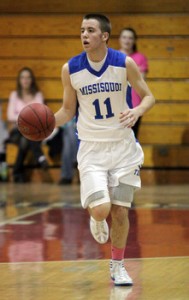
Don’t let St. Amour’s early shooting numbers deceive you. He has been everything we hoped for thus far.
Damon: I think Matt Daley has the best chance to be a consistent offensive threat for Middlebury going forward. His performance in practice last season drew rave reviews from his teammates and we caught a glimpse of his actualized potential in his first game this season. As you mentioned, the biggest concern isn’t about his experience or whether he can play at the speed of the game, but rather his ability to impact the game to the degree that he should, whether the issue is passivity on his part or a shortage of touches due to poor execution from his teammates. Having said that, I agree that St. Amour is probably the safest bet, given his approach to the game and his role in the offense. You outlined some of the many things that St. Amour does well earlier and I think we will only see his role increase as the season progresses, as a result. When he and Daley are on the floor, the offense operates at a higher level because both guys are remarkably adept at spacing the floor and are willing passers who make the players around them better. I do think that St. Amour will be a streaky scorer this season as a freshman, along the lines of what we’ve seen so far, but the maturity of his game in other areas is striking. Jake Brown, as we suspected, is a little behind St. Amour in terms of his development as a complete player, but what I love about his approach—and St. Amour shares this—is his confidence. Both guys are tremendously talented players and they understand that, even when their shots aren’t falling or they’re struggling to make plays (you might call it the Jake Wolfin effect). I think Jake Brown’s role is one of the more intriguing questions that remains to be determined. I agree that he’s likely a 10-15-minute-per-game player who provides energy and ballhandling off the bench, but I think he may also enjoy the most significant improvement over the course of the season as the game slows down for him and his role becomes clearer. St. Amour and Daley both appear primed to step into crucial roles offensively as NESCAC play begins, but don’t be surprised if Jake Brown makes big plays down the stretch.
Middlebury is ranked 19th in the country heading into 2014. Is that too high, too low, or just right?
Jeff: I think it is just right. After three years of watching other conferences, I’ve come to believe that there aren’t a lot of great teams in Division III. This year, Illinois Wesleyan and UW-Stevens Point (led by the incredible, must-watch Tyler Tillema) are total powerhouses, and a few other teams in the midwest are dominant, but there isn’t depth of greatness across the country. So, why shouldn’t Middlebury be any higher than 19th? Because I don’t think Middlebury is great either. The defensive weakness, softness on the boards, and struggles finding an offensive identity all give me reason to believe that this team, if it makes the NCAA tournament, will not have a substantial chance of making Salem.
What is the biggest storyline/takeaway of the fall semester in the conference?
Damon: The biggest storyline from the first semester has been the play of Bowdoin. Prior to this season, Middlebury had been unbeaten against pre-New Years opponents dating back to 2008, but the Panthers have been the exception in the NESCAC in that regard. Yes, Middlebury, Bowdoin and most everyone else plays a vanilla non-conference schedule, but playing consistent basketball over a nine-game stretch is impressive and has put the rest of the league (and its esteemed bloggers) on notice. What the Polar Bears have accomplished is particularly remarkable given the offseason injury sustained by point guard Bryan Hurley, who was a burgeoning star in the conference, and may not play at all this season.
Whether Bowdoin can replicate its non-conference success against NESCAC competition remains to be seen, but after tempering our expectations for the Polar Bears after learning of Hurley’s injury, Bowdoin’s success is clearly the storyline of the first semester, for me. The question now, is whether the Polar Bears have enough ballhandling to make a run in the NESCAC.
Jeff: For me, the biggest storyline of the fall semester is Duncan Robinson. The Williams freshman, who we have been following with a combination of fear and excitement for the better part of two years, and who we picked to win conference rookie of the year, might already be one of the best five players in the NESCAC. In 10 games, the 6’7” wingman is averaging 15.0 points on 57/47/96 shooting, to go along with 7.2 rebounds, 2.0 assists, and 1.8 blocks per game. When I’ve seen him play, he looks at least that good. The game comes to him effortlessly and I don’t see anyone slowing him down. I think NESCAC fans are going to be talking about Duncan Robinson for longer than anyone else we have seen come through the conference in the last four years.
Damon: I saw Duncan Robinson play for the first time in the spring of 2012 when he visited Middlebury and I’ve been awed by his ability ever since. But I hadn’t seen those numbers yet. 15 points per game on those shooting splits as a freshman is incredible. If he somehow improves in NESCAC play he’s deserving of Player of the Year consideration.
Is Bowdoin actually a legitimate conference title contender?
Damon: It’s hard to know what legitimate title contender means, exactly, though I would lean towards yes, in the sense that after Williams and Amherst, the gap between Middlebury, Tufts and Bowdoin isn’t as significant as the dropoff that follows between the fifth and sixth best team in the NESCAC. This might be conservative on my part, but it’s hard to rule Bowdoin out, given their start, without seeing a single NESCAC matchup. Furthermore, I think Bowdoin will give certain teams fits. John Swords is a matchup nightmare for just about anyone in the conference and Andrew Madlinger and Keegan Pieri are effective wing scorers for the Polar Bears. I still think Williams is a heavy favorite to hoist the conference crown, but I think that Bowdoin has an outside shot (and that qualifies as legitimate in my book) at a NESCAC title.
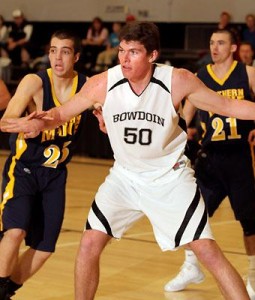
John Swords is breaking out and leads an undefeated Bowdoin into the New Year
Jeff: No. Bowdoin is a lot better than I expected, and the emergence of 7’0” John Swords (15.4 ppg, 9.9 rpg, 3.2 bpg, 71% FG) is one of the top storylines of the season thus far. Two other guys I’ve really enjoyed watching are sophomore Lucas Hausman (10.2 ppg, 46/19/93 shooting) and senior Grant White (you might know him as Bowdoin football’s oft-injured quarterback), who has stepped into Hurley’s spot in the rotation admirably (9.1 ppg, 3.2 apg, 52/54/59 shooting). But all of those numbers are inflated by a weak schedule, and Bowdoin’s offense is limited (73.7 ppg, 8th in the conference). I could see them finishing ahead of any one or two of Tufts, Middlebury, Amherst, and Williams, but not winning the conference.
What Middlebury player do you expect to step up his game after the break?
Damon: As I mentioned earlier I think both Matts (Daley and St. Amour) should have strong 2014 seasons, but I’m not sure that has as much to do with improvement as it does with greater opportunity. The player I expect to demonstrate the most improvement in the second semester is Jake Brown, particularly as a scorer. Brown is already a polished finisher around the basket and his combination of quickness and excellent ball-handling should open lanes to the basket. Despite playing a shade under 20 minutes per game, Brown is averaging fewer than five points per game on 41.7 percent shooting. As his shot recognition improves and he adapts completely to the speed of the game I think we’ll see even more attacks at the rim and fewer long jumpshots. Like Jake Wolfin before him, Brown appears able—as most good players are— harnessing his jumpshot for sustained scoring bursts, but at least as a freshman, Jake will be most effective working off the dribble, getting into the paint and either dishing to open teammates or finishing around the basket.
Jeff: My pick would be St. Amour, but I already discussed what impressed me about his game and the positive signs I see going forward. I’m going to go with Nate Bulluck, a guy who’s spot in the rotation isn’t a given, but who quietly put together a really nice fall. He has improved his ball-handling and shooting, and brings an assertive offensive mentality off the bench. He can hit open shots, play hard defense, and has a knack for drawing fouls while driving to the basket. He is a senior, and he looks determined to win. I think he turns the tide in a few big games this year.
In the past, teams have received important contributions from “undervalued” guys (e.g. Jamal Davis in 2011, Peter Lynch as a junior in 2012). Do you see a guy on this team playing that role?
Jeff: My answer is the same as the last question: I expect Nate Bulluck to be that guy. If not Bulluck, my choice is Jake Nidenberg. He put up 7.5 points in 15 minutes per game in the fall, and is a strong, efficient, productive presence in the paint. He looked off during the last couple of games, but Coach Brown will give him opportunities heading forward, and his scoring numbers will surprise.
Damon: Like you I’ve been really impressed by Nate Bulluck so far this season. Over the years I’ve always admired Bulluck’s moxie, but this year in addition to that unrelenting energy and fierce competitiveness, Bulluck has exuded a sense of maturity that is noticeable in both his play on the floor, but also off the court as well. In the past Nate has made his fair share of “No-No-Yes!” plays (and also a couple of “No-No-NO!” plays, too), but his drastic improvement as a ball-handler and a shooter have assuaged some of the latent anxiety I have felt in the past when he’s on the floor. He has developed a comfortable three-point shot that he takes without hesitation and is especially effective from either wing. His ability to knock down the three and create his own shot at times has helped replace some of the offensive role that might otherwise belong to Dylan Sinnickson. As in season’s past, Bulluck is at his best when he is orchestrating a Middlebury run—if nothing else having a player who can come off the bench and work against the flow of a game is valuable—but the senior guard has likely earned a larger role in the rotation this season as a spot-up shooter, strong-bodied defender and aggressive rebounder, particularly on the offensive glass. Bulluck may indeed spark a comeback or two this year, but he will also play an understated role in Middlebury’s success from one game to the next.
Middlebury plays Bowdoin, Tufts and Williams (likely 4 of the 5 best teams in the NESCAC) at home this season and there is a ton of talent between them. What individual player are you most excited to see play?
Jeff: I have already discussed two of the top candidates, Duncan Robinson and John Swords. Outside of those two, I am really looking forward to seeing Tufts freshman Hunter Sabety, a 6’8” monster who leads the team in scoring (13.6), rebounding (7.4), blocks (2.3) and field goal percentage (63%). He is likely the second best freshman in the conference behind Robinson, and I look forward to seeing how he matches up with Roberts, Jensen, Churchill, and whomever else Jeff Brown throws at him. By the way, Tufts has six guys in double figures while last year’s leading scorer, Ben Ferris, has yet to play, but should soon. That offense has scary potential.
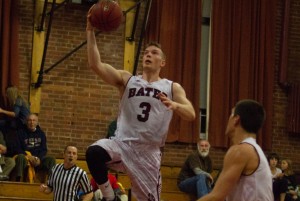
Graham Safford is keeping Bates in the hunt.
However, the player I am looking forward to seeing most does not play for one of the teams you mentioned, and that is Graham Safford of Bates. Panther fans may remember him for his 19-point performance off the bench two Januarys ago, but after two years of inconsistent play, the junior is hitting on all cylinders in 2013-14. Taking on ball-handling duties in the wake of the injury to Luke Matarazzo, Safford is averaging 20.6 points and 5.7 assists, and 2.2 steals per game. He is 3rd in the conference in each of those categories. He can go on scorching hot runs where he is in total control on the court, and I expect him to make that January 10 game close.
Damon: Way to go above and beyond for the reader, Jeff, and to answer the “best” question possible, rather than the one that was posed (though I should have thought about Safford when I made the list). There’s so much great talent in the NESCAC this year (perhaps it’s just present-dominated thinking, but I don’t know if the league has been this good the past 4-5 seasons) that it’s difficult to isolate just one or two guys to watch. Along those lines, I really can’t wait to watch Williams play (technically the final game of my Middlebury career!); the top talent on their roster is remarkable. Michael Mayer somehow remains underrated, despite averaging nearly 18 and 9 on 57/37/76 splits last season, and Boston College transfer, Ryan Killcullen, who we expected to have a big 2012-13 season, has finally found his role in Mike Maker’s tough-to-crack rotation. I’ll be especially excited to watch Duncan Robinson play, particularly since opportunities to watch him in person may be sparse after this year. But the player I’m most looking forward to watching is Daniel Wohl, whose skillset—unlimited, as far as I can tell—intrigues me most. After battling mononucleosis for most of the regular season, Wohl recovered in time to blitz Middlebury for 19 points (and seemingly every big shot) in 31 minutes off the bench in Williams’ NESCAC semifinal victory last season. Listed as a 6’6’’ guard, Wohl can handle the ball, shoot the three and rebound the basketball (he ranks second on the team in assists, fourth in threes made and three point percentage and third in rebounds per game). By all accounts, Wohl is also an outstanding defender, which means his abilities align very closely with those of Willy Workman, another player whom I particularly enjoyed watching. Having said that I’m not nearly as acquainted with Wohl’s game as I was with Workman’s—thanks (or no thanks) to his performance at Pepin a season ago that will be marked indelibly in my mind—and I’m really looking forward to watching Wohl play and better evaluating him—and his team—with my own eyes.
What do you project the final conference standings (regular season) to be?
Damon:
1) Williams — The Ephs have easily the highest ceiling (an Amherst-type run to the national championship game wouldn’t surprise me) of any team in the NESCAC. Thus far they have failed to play to their potential, but as Amherst taught us a season ago, it’s safer to bet on talent at this point than quality of play.
2) Amherst — After Williams, the Lord Jeffs have the best one-two scoring punch in the conference in Aaron Toomey and Connor Green. Green improved considerably over the course of the NCAA Tournament last season, capped off a by an impressive performance in the national championship game and has taken another leap forward to begin the season. Amherst has dangerously little depth, but Toomey and Green will carry the offense, while David George anchors an improved defense that will considerably limit opposing teams’ scoring chances inside the paint.
3) Middlebury — The third spot is something of a toss up right now, with three teams that haven’t separated themselves by their play, with some consideration being given to preseason expectations. Middlebury takes this spot in my mind because the Panthers have the best combination of established players (I’m relying on the dangerous “been-there-before” argument to a degree) and outstanding young talent of the three. Middlebury also has the considerable benefit of playing both Bowdoin and Tufts (not to mention Williams, Bates and Colby as well) at home where the Panthers have been especially tough to beat over the past four years. It’s nearly impossible to imagine Middlebury losing more than three games given their schedule breakdown and an 8-2 or 9-1 finish seems well within reason.
4) Bowdoin — The Polar Bears competed in the conference a season ago and should take the next step this year as a top-four team in the conference. Tufts undoubtedly has a higher ceiling than Bowdoin, but the Polar Bears have demonstrated a consistency that the Jumbos have not.
5) Tufts — I’m skeptical (though I have no inside information) that Ben Ferris will be able to return and play at a high level after sustaining a pelvis injury. Resting any team’s hopes on a player’s successful return from injury is dangerous, as Middlebury fans learned from Sinnickson’s struggles to return last season (he, too, was originally expected back in early January, but ultimately sat out the remainder of the season). In Ferris’s absence, Tufts has struggled to win tight games against quality competition, something that ailed them last season as well. Getting over the hump in the NESCAC is difficult and until Tufts demonstrates they can do it, they will be an immensely talented, but incomplete team. A healthy Ferris could push Tufts into title contention, but for now my expectations are (comparatively) minimal for the Jumbos.
6) Bates — Star power is scarce at the bottom of the league and Bates has a couple different players that can take over games, including Graham Safford who has had a First-Team All-NESCAC-caliber start. The Bobcats also enjoy a considerable homecourt advantage and have the talent to beat Wesleyan and Connecticut College on the road.
7) Hamilton — At the risk of sounding flippant (and being proven wrong), the bottom four teams in the conference are competing for the final two spots in the tournament and not much else. Matt Hart is an electric player and a natural scorer and there are a couple of nice players around him, but even if the floor is somewhat high for Hamilton, the ceiling is not much higher.
8) Colby — The Mules already have double-digit losses at home (nonconference) to both Bowdoin and Bates. Chris Hudnut rounds out the NESCAC’s extremely talented crop of big men, but he will not have enough help around him this year to make a significant difference.
9) Trinity — There are some interesting pieces for the developing Bantams, but they are a year away from being an up-and-comer.
10) Wesleyan — The Cardinals were decimated by graduation—an indicator of the difference between an established top-tier team (Middlebury/Amherst) and a great class (Wesleyan). All three teams lost nearly the same amount of talent, but the Panthers and Lord Jeffs will compete for a NESCAC title, while the Cardinals will enter the relegation (just kidding!) zone.
11) Connecticut College — It’s going to be another tough year for the Camels who play home games against Middlebury, Tufts, Bates, Williams and Hamilton this season.
Jeff:
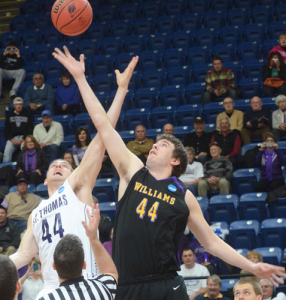
Despite an opening night loss to Southern Vermont, Michael Mayer and Williams are primed for a National Title run.
1) Williams — Too much offensive talent. Mayer, Robinson, Epley, Wohl, Kilcullen, and Rooke-Ley are probably six of the 20 best players in the league.
2) Amherst — By far the hardest pick. I don’t believe in Amherst as separating itself from the next three teams, but I don’t believe in any of the next three teams that much either. Connor Green and Aaron Toomey have been spectacular on offense this season, and they have strong support in David George, David Kalema, Tom Killian, and Ben Pollack. In a year when defensive play is down around the league, that might be enough.
3) Tufts — When Ferris comes back, they replace Middlebury as the deepest team in the league.
4) Bowdoin — Swords could replace Mayer as the first-team center if he maintains his current play, and the team defense numbers (58 ppg, 5th in the country) hold.
5) Middlebury — Joey Kizel will have something to say about this, but I don’t think this team is playing with the consistency and urgency it needs to stay in the hunt.
6) Bates — Safford and Mike Boornazien form a lethal backcourt.
7) Colby — Center Chris Hudnut is off to a remarkable start (18.6 ppg, 7.4 rpg), but has limited help.
8) Hamilton — Worst defense in the league, and no real weapons outside of sophomore star Matt Hart.
9) Trinity — Struggles on offense suggest they can’t keep up with most of the conference.
10) Wesleyan — Top four scorers are underclassmen. Good for the future, bad for the present.
11) Connecticut College — Might be another winless conference season for the Camels. Disappointing showings from Aaron McBurnie and Rob Harrigan, in particular.
Damon: Joey Kizel won’t be the only one with something to say about this ranking. My biggest critique is that consistency and urgency in nonconference play only go so far. Of course it is preferable to a lack thereof, but I still think Middlebury has the talent—and will—to improve as the season goes on. Jeff Brown’s team answered a lot of questions for me in their win over Skidmore before the break. Obviously you don’t want to take away too much from one result, but the intensity and execution was there throughout for the team. A rotation of inexperienced players was always going to require time to develop and Middlebury had (and may still have) some frustrating moments, but the foundation has been built for a run in the NESCAC.
